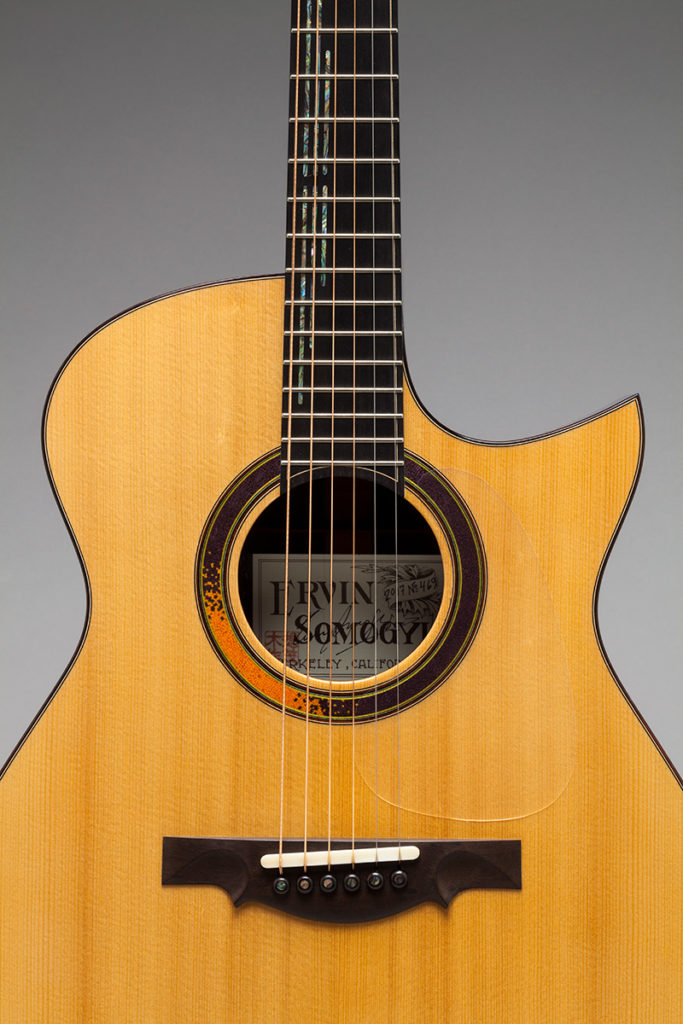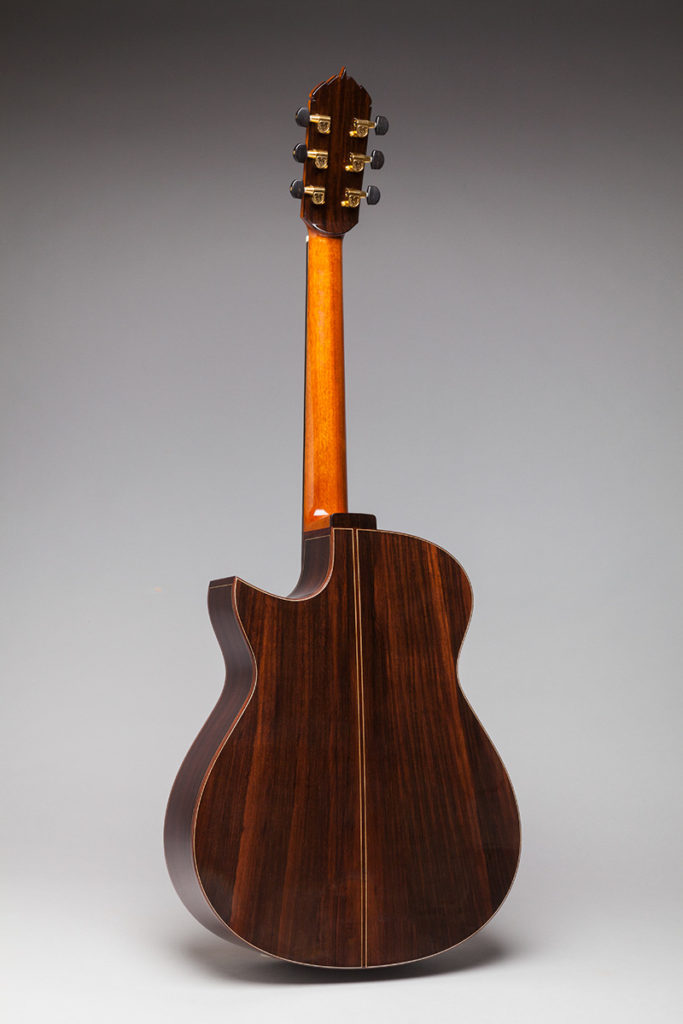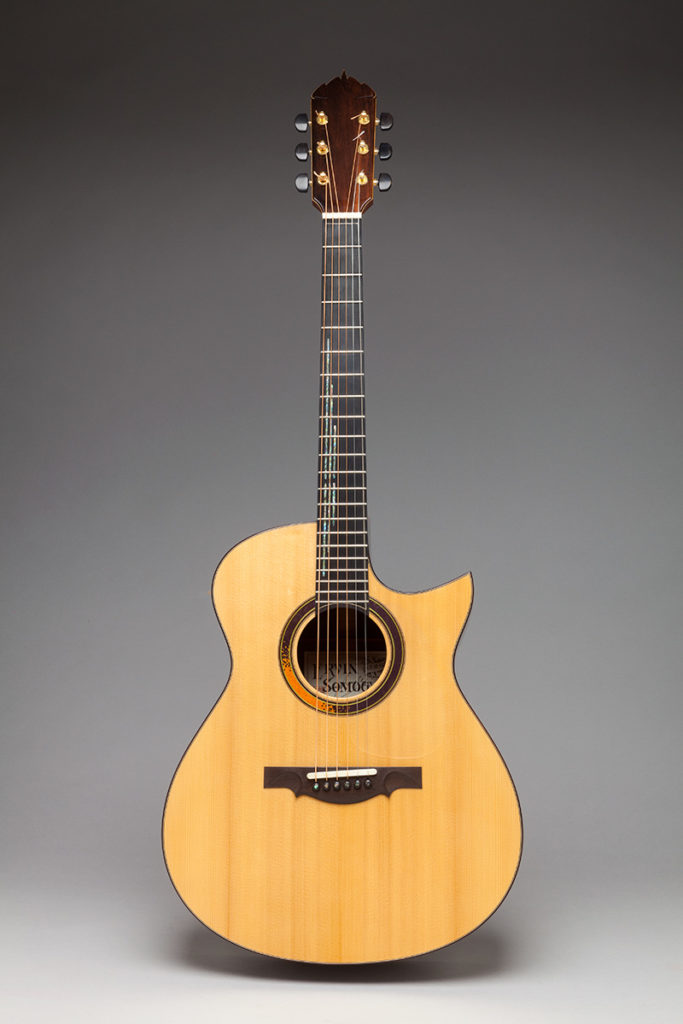This is a new OM Cutaway guitar. It has the following features:
- Brazilian rosewood back and sides (see note #1 below)
- Sitka spruce face
- Mahogany neck and head with the hand-shaped “Somogyi” design
- Peghead with front and back decorative veneers, and a carved volute at the head-neck junction
- Sculpted ebony bridge with a wide compensated bone saddle
- Bone nut with decorative scalloping
- Multiple-piece back (see note #2 below)
- Excellent workmanship throughout
- “Made by So-Mo-Gi” stamp on the label (see note #3 below)
- French polish finish (see note #4 below)
- Transparent pickguard
- Gold Schaller tuners with ebony buttons
- Sunset mosaic rosette (see note #5 below)
- Intelligent bracing and voicing (see note #6 below)
- Bound ebony fingerboard with linear abalone inlays (see note #7 below)
PRICE: $40,000
————————–<>————————-
NOTE #1: The Brazilian rosewood comes with CITES paperwork.
NOTE #2: The dominant look of today’s guitar backs is that of two-piece construction. Sometimes one has perfectly good woods that are not quite wide enough to make a two-piece back, and in those cases one can add some matching wing-pieces to fill the dimensions out and create the look of a two-piece back (while technically being a four-piece back). Sometimes wood that has been cut from the waist area can be added to the lower bout, to widen it just enough. This is a perfectly satisfactory and legitimate procedure, and so long as the back has a homogeneous look and the glue joints hold this is not a problem in any way.
Occasionally backs that contain more than four pieces are made out of narrow but straight-grained stock that can maintain consistency of coloration and grain if slices of it are put together side by side, and still support the look of a two-piece back. This guitar has a ten-piece back and no one would ever know it if I didn’t mention it.
A multiple-piece back is functionally no different from a two-piece back, and visually no different if the work is carefully done with suitable wood. It actually represents added value because someone took the time to do that work.
NOTE #3: Each of my guitars’ labels carries a stamp with 4 Japanese Kanji characters. Kanji are equivalent to styles of print, or fonts, and there are several kinds/styles of Kanji. The present style is one in which each character not only has its own sound, but also has a separate symbolic meaning that designates, symbolizes, or represents an object or an action. There is nothing like this in English grammar. My name, in Japanese, is pronounced SO MO GI (with a hard “g”, as in the word garden). The second, third, and fourth characters on this stamp correspond to each of these sounds. The first character means “made by”. Accordingly, the surface meaning of this stamp is “Made by SO MO GI”. So far, so good. Its symbolic message, however, is particularly appropriate to my work. The SO character also means “imagine”. The MO character signifies “growing” or “growth”. The GI character signifies “a tree”. Therefore this stamp, in addition to identifying the maker of this guitar, means “imagine the growth of a tree”. It’s wonderfully appropriate to the work that I do.
NOTE #4: French polish is the hand-application of a shellac finish that is at the end rubbed out to a high gloss. It was the traditional and best finish for wood in the days before lacquers, urethanes, catalyzed and ultraviolet-cure finishes, etc., arrived on the scene. French polish has several advantages, and perhaps a few disadvantages. One great advantage is that it is very thin compared with any of the other finishes that are used these days; this allows the guitar’s main diaphragms (the top and the back) maximum freedom of vibratory movement; this results in a louder and more present sound.
It is a non-toxic finish, as its solvent is alcohol. One can dissolve the shellac flakes in either ethanol or methanol; the principal difference is that one can drink ethanol, but not methanol; the latter is poisonous. [NOTE: Methanol itself was created during Prohibition . . . that period of time in the 1920s when Americans decided that alcohol was a tool of the Devil and needed to be abolished. Accordingly, petrochemical impurities and additives were mixed in with ethanol so as to render it poisonous for humans to drink. As we all know, Prohibition eventually went away; methanol did not. The reason that we still have methanol is that the liquor industry doesn’t want its customers getting their booze from the local hardware store.]
The thickness of a properly applied French polish is anywhere between the thickness of a soap bubble (.001) and the thickness of a sheet of typing paper (.004”). Lacquers are often on the order of .008” to .012” thick, and lacquer is a denser substance than shellac is.
One can sometimes see cracks in the finishes of older lacquer-coated guitars. This is called “crazing”, and it happens because the lacquer is thick and hard enough to crack over time. French polish is not subject to crazing. The crazing is not a problem, really; the heaviness of the lacquer is, though — as far as guitar sound is concerned. Because of its relative heaviness, a lacquer finish will damp the sound of a guitar much more so than a French polish ever could.
One disadvantage of French polish is that, because it is so thin, it does not protect a guitar against scratches and wear as does a lacquer finish. French polish is so thin that it offers minimal protection. However, the principal function of any finish — besides enhancing the woods that it covers — is to protect wood against changes in the weather. Wood is hygroscopic; that is, it swells and shrinks depending on how much moisture is in the air. That movement can promote cracking and checking in woods. Therefore, I tell my customers that the function of a French polish is to (1) allow the instrument its full and present voice, and to protect its woods from the weather . . . but not the player. I expect people who own my guitars to take reasonably good care of them.
Nonetheless, in case of damage, French polish is easy to touch up by anyone who knows how to work with it. And speaking of knowing how to work with it, mastery of French polishing is a genuine skill; it takes less skill to apply lacquer onto a wooden surface with a spray gun. Along with that, the urethane, polyurethane, and ultraviolet-cure finishes are not easy to repair in case of damage. The entire finish has to be removed, and a new one reapplied.
There is one other thing: lacquers and the synthetics are high-gloss finishes. They are so brightly reflective . . . even “plasticky” . . . that they typically get in the way of one’s appreciating the woods themselves; the reflectivity gets in the way. Take a look at your own lacquered guitar and you’ll see what I mean. A French polish is shiny but not so glossy that it gets in the way of appreciating the colors and visual depth of the woods; these look more beautiful, and have more depth, even indoors where there is artificial lighting.
NOTE #5: The rosette is the traditional decorative inlay around the soundhole. Its original job was to keep bad spirits away. Really. Five or six centuries ago, when wooden string instruments were first being invented and made, it was believed that devils would inhabit the dark recesses behind the soundholes. Accordingly, beautiful designs were brought in that were thought to discourage these bad spirits from settling into the dark areas inside lutes, citterns, mandolins, theorbos, and proto-guitars. More recently, the job of the rosette has been to beautify the instrument. It doesn’t really do anything else; it does not affect playability, tone, projection, or sustain.
Factories install the easiest and most trouble-free rosettes that they can; frequently these are two or three concentric circles made of either plastic or wood. Luthiers frequently go to all kinds of trouble to make rosettes that are distinctive and unique. These too are circular and they are often of wood mosaic designs where a design element is repeated all around. Such rosettes typically contain between 3,000 and 4,000 little pieces of wood.
The rosette on this guitar is a wood mosaic one, but it is different in that it’s not the same look all around. I call this my “sunset” rosette, because the colors are crepuscular. I like that word; it refers to the twilight-like quality of light becoming darkness, or darkness becoming light. It reminds me that part of a sunset or a sunrise when you can only just see things as it gets darker, or just begin to see things as the sky begins to lighten. I think it looks beautiful.
NOTE #6: I find the process of the voicing of a soundbox to be fascinating. I specialize in this work, and am considered to be an authority on it. Each guitar is a bit different and there’s always something new to learn . . . depending on the size of guitar, the species of wood being worked, the specific bracing layout in question, the temperature and humidity in the room in which the work is being done, the qualities of tone that my customer/client has voiced a preference for, and even the size of the soundhole/soundport.
“Voicing work” is that series of procedures that focus on shaping the vibrating plates and their components (the braces) to the specific thicknesses, stiffnesses, profiles, tapers, etc., that will allow the instrument to have its fullest and sweetest voice. It’s a bit like surgery combined with engineering: one needs (1) to have an idea of just where to cut, shave, taper, sand, and shape the wood, and (2) exactly how much of it to do, and (3) what it does – that is, to know what kinds of manipulations of relatively small amounts of wood will shift the sound of the instrument in this or that direction — and (4) to have a sense of having gone not far enough or having gone too far.
It’s an essential skills-set that takes time to learn and master, but it is one that is not taught in any of the schools nor mentioned in any of the many how-to books that are in print . . . with one exception. As far as I know I’m the only luthier who had described these procedures in written form; they are the subject matter of chapters 18 and 19 of my book The Responsive Guitar. This is not necessarily because I’m smarter than other luthiers; rather, it is (1) because I’m a better writer than a lot of them are and, more importantly, (2) it is a procedure that is so hands-and-ears-on, and so full of subtlety, that it’s difficult to describe with mere words. The woods have to feel and sound right.
Voicing work is necessarily part of structural work. One of the most important adages in Spanish guitar making is to make the guitar so that it is “on the cusp of disaster”. That means that it is NO STRONGER than it needs to be to hold together under string tension and the rigors of being played; and it is NO WEAKER than that either, because to make it so will ensure eventual failure (breakage or collapse). One can understand that a soundbox that is built to that balance point will be able to vibrate and resonate as fully as possible . . . because it is not being held back by superfluous mass or stiffness . . . and that it is simultaneously strong enough to hold together. It’s a tricky balance point to achieve.
The pacing of Voicing work is rather slow. I remove small amounts of wood from here and there, and listen to the change in tap tone that that removal produces. I use the sounds of various types of tap tones as an indicator of how track how close to “right” the soundbox is at. This work takes me a full day, and often two days, to do properly. I not only listen to the progression of the guitar top’s tap tones, but I periodically press on the wood gently with my thumb; I can sense the top getting looser and more yielding as I remove wood. It’s a little bit like doing C.P.R., where the subject’s rib cage sinks in as one applies rhythmic pressure — except that in this case the pressure is not great. My guess is that if you try this with whatever guitar or guitars you now own the top(s) will not move easily under your hand’s push. That’s how other guitars are built.
I once showed one of my clients my procedure for Voicing, on the guitar I was making for him; he had been persistent in asking me to do this and I finally agreed — on the condition that he not photograph nor ever describe the procedures to anyone else. Afterwards, he said it was like watching his favorite color of paint dry. But from my point of view this is always a meditative process in which I “converse” with the soundbox; and I cannot do this if I’m thinking of anything else. No one can; one has to be relaxed and focused on the task.
On the whole, I must be doing something right. My guitars do have the reputation of sounding good.
NOTE #7: I discovered a long time ago that a fingerboard with a border (its binding) around it looks more elegant than one without, and on which the fret slots are visible on either side of the fingerboard. Most commercially made guitars have plastic fretboard binding on either side of the fretboard only; mine have wood binding on all four sides – with all the corner elements nicely mitered together. And in echo of the look of the guitar’s binding and purfling, these bound fingerboards contain a contrasting “pin stripe” of purfling as well.
MANDATORY SURGEON GENERAL’S WARNING: The sound of Somogyi’s guitars has been found to be so intoxicating that you are seriously warned to not play any of them while driving or operating heavy machinery.



